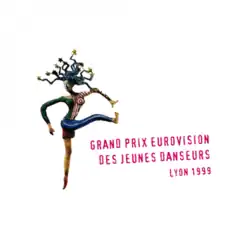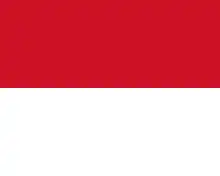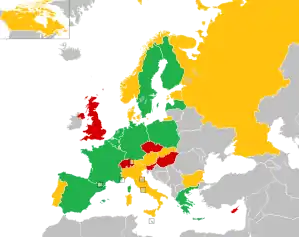Eurovision Young Dancers 1999
The Eurovision Young Dancers 1999 was the eighth edition of the Eurovision Young Dancers, held at the Opéra de Lyon, in Lyon, France, on 10 July 1999.[1] Organised by the European Broadcasting Union (EBU) and host broadcaster France 3, dancers from ten countries participated in the televised final. A total of sixteen countries took part in the competition. Czech Republic made their début while host country France, Netherlands, Switzerland and United Kingdom returned. Estonia and Slovakia decided not to participate.[1]
| Eurovision Young Dancers 1999 | |
|---|---|
 | |
| Dates | |
| Semi-final | 4 July 1999 |
| Final | 10 July 1999 |
| Host | |
| Venue | Opéra de Lyon, Lyon, France |
| Presenter(s) | Alex Taylor |
| Directed by | Guy Darmet |
| Executive producer |
|
| Host broadcaster | France 3 |
| Website | youngdancers |
| Participants | |
| Number of entries | 16 |
| Debuting countries | |
| Returning countries | |
| Non-returning countries | |
Participation map
| |
| Vote | |
| Voting system | A professional jury chose the finalists and the top 3 performances |
| Winning dancers | Stegli Yohan and Katja Wünsche |
Both single dancers and couples younger than 20 could enter the competition, male or female. Single dancers had to perform 2 pieces of maximum 10 minutes in total, while couples could choose to perform 1 or 2 dances, but in total no longer than 10 minutes as well. The semi-final that took place in the same venue 6 days before the final (4 July 1999).[1]
The non-qualified countries were Cyprus, Czech Republic, Hungary, Slovenia, Switzerland and United Kingdom. Katja Wünsche and Stegli Yohan of Germany won the contest, with Sweden and Spain placing second and joint third respectively.[2]
Location

Opéra de Lyon, in Lyon, France, was the host venue for the 1999 edition of the Eurovision Young Dancers.[1]
The Opéra Nouvel (Nouvel Opera House) in Lyon, France, is the home of the Opéra National de Lyon. The original opera house was re-designed by the distinguished French architect, Jean Nouvel between 1985 and 1993 in association with the agency of scenography dUCKS scéno and the acoustician Peutz. Serge Dorny was appointed general director in 2003.
Format
The format consists of dancers who are non-professional and between the ages of 16–21, competing in a performance of dance routines of their choice, which they have prepared in advance of the competition. All of the acts then take part in a choreographed group dance during 'Young Dancers Week'.[3]
Jury members of a professional aspect and representing the elements of ballet, contemporary, and modern dancing styles, score each of the competing individual and group dance routines. The overall winner upon completion of the final dances is chosen by the professional jury members.[3]
The interval act was a performance by the hip-hop dance group "Kä-fig".[1]
Results
Preliminary round
A total of sixteen countries took part in the preliminary round of the 1999 contest, of which ten qualified to the televised grand final. The following countries failed to qualify.[1]
| Country | Participant | Dance | Choreographer |
|---|---|---|---|
| Dafni Mouyiassi | "The Sleeping Beauty" | M. Petipa | |
| Lara Glew | "La Bayadère" | M. Petipa | |
| Attila Bongar | "Le Corsaire" | M. Petipa | |
| Lukas Slavicky and Zuzana Zahradnikova | "Don Quixote" | M. Petipa | |
| Ana Klasnja | "Variation of Giselle" | J. Coralli and J. Perrot | |
| Laetitia Guggi | "La Bayadère" | M. Petipa |
Final
Awards were given to the top three countries. The table below highlights these using gold, silver, and bronze. The placing results of the remaining participants is unknown and never made public by the European Broadcasting Union.[2]
| Draw | Country | Participant | Dance | Choreographer | Result |
|---|---|---|---|---|---|
| 01 | Maria Boubouli | "Don Quixote" | M. Petipa | - | |
| 02 | Ernst Meisner | "La fille mal gardée" | J. Dauberval | - | |
| 03 | Clara Blanco | "Variation of Giselle" | J. Coralli and J. Perrot | 3 | |
| 04 | Emmanuel Eggermont and Juliette Roudet | "Les Chiens" | J. Bouvier and R. Obadia | - | |
| 05 | Marta Wojtaszewska and Marcin Krajewski | "Stars & Stripes" | G. Balanchine | - | |
| 06 | Elza Leimane | "Esmeralda" | J. Perrot | - | |
| 07 | Aarne Ruutu | "La Sylphide" (James variation) | A. Bournonville | - | |
| 08 | Katja Wünsche and Stegli Yohan | "Cinderella" | J. Neumeier | 1 | |
| 09 | Frederik Deberdt | "La Sylphide" | A. Bournonville | - | |
| 10 | Nathalie Nordquist | "Flower Festival in Genzano" | A. Bournonville | 2 |
Jury members
The jury members consisted of the following:[1]
 Russia – Boris Eifman (Head of Jury)
Russia – Boris Eifman (Head of Jury) France – Maguy Marin
France – Maguy Marin.svg.png.webp) Australia – Meryl Tankard
Australia – Meryl Tankard France/
France/ Monaco – Jean-Christophe Maillot
Monaco – Jean-Christophe Maillot Finland – Tero Saarinen
Finland – Tero Saarinen Spain – Vicente Sáez
Spain – Vicente Sáez Greece – Victoria Maragopoulou
Greece – Victoria Maragopoulou
Broadcasting
A total of 20 countries broadcast the 1999 event, including Croatia, Ireland, Norway and Russia.[4] Agnes Letestu, the 1989 Eurovision Young Dancers winner, commented on this year's contest for the host broadcaster France 3. In the United Kingdom, highlights of the contest was broadcast as part of BBC Two series Summer Dance.[5]
.svg.png.webp) Belgium (RTBF)
Belgium (RTBF) Croatia (HRT)
Croatia (HRT).svg.png.webp) Cyprus (CyBC)
Cyprus (CyBC) Czech Republic (ČT)
Czech Republic (ČT) Finland (YLE)
Finland (YLE) France (France 3, MEZZO)
France (France 3, MEZZO) Germany (ZDF)
Germany (ZDF) Greece (ERT)
Greece (ERT) Hungary (MTV)
Hungary (MTV) Ireland (RTÉ)
Ireland (RTÉ) Latvia (LTV)
Latvia (LTV) Netherlands (NPS)
Netherlands (NPS) Norway (NRK)
Norway (NRK) Poland (TVP)
Poland (TVP) Russia (RTR)
Russia (RTR) Slovenia (RTVSLO)
Slovenia (RTVSLO) Spain (TVE)
Spain (TVE) Sweden (SVT)
Sweden (SVT).svg.png.webp) Switzerland (DRS, TSR, TSI)
Switzerland (DRS, TSR, TSI) United Kingdom (BBC)
United Kingdom (BBC)
See also
References
- "Eurovision Young Dancers 1999: About the show". European Broadcasting Union. Retrieved 5 October 2014.
- "Eurovision Young Dancers 1999: Participants". youngmusicians.tv. European Broadcasting Union. Retrieved 5 October 2014.
- "Eurovision Young Dancers - Format". youngdancers.tv. European Broadcasting Union. Archived from the original on 11 February 2015. Retrieved 8 March 2015.
- "Eurovision Young Dancers 1999". Issuu. Retrieved 2 May 2018.
- "Summer Dance". 14 August 1999. Retrieved 10 October 2022 – via BBC Genome.
